|
|
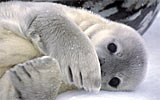
|
||
 |
|
|||||
| Antarctica Picture | Antarctica Cruise | Facts | History | Boots | Store | Clothes | Whales | Books | Video | Schools | Forum | Site Map | FIDS / OAE's |

| Whaling pictures | Whales | Species | Whaling Antarctica 1 2 | Whales & food webs | Whaling cards |
| Whales species: Blue | Fin | Humpback | Minke | Orcas | Right | Sei | Sperm | Sperm whale tales |
| Whale pictures to buy Beluga whale Blue whale Bowhead whale Grey whale Humpback whale Killer whale Right whale Sperm whale |
These cigarette cards were issued by Ogden's Tobacco in Great Britain in 1927 and they're a great easy-to-digest illustrated guide to the whaling industry, particularly as they represent a time just before industrial whaling really started in earnest.
The descriptions are carefully written, concise and as detailed as the small space on the back of a cigarette card will allow. As I typed up the writing on the back of each card I developed a real respect for the writer of that text who had to get across as much accurate information on the subject in such a limited space while still fitting into the overall thread of the other cards.
The card captions are presented here exactly as on the back of each card. While reading, bear in mind that what you are reading was written in 1927 and so any references to "modern" or "recent" refers to that time.
|
|
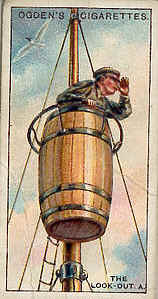 2
The Look Out - A. Greenland type 2
The Look Out - A. Greenland typeOn board a whaler the "Look out" is of first importance, and four men keep watch from the mast-head while daylight lasts. The "Look-out" is a simple affair. In the Arctic and Antarctic seas it is necessary to protect the watch from the severe cold and the Look-out is made in the form of a barrel, to which a handrail is fitted. Simple as this sounds it has proved very effective, and is the type used in all whalers of the Arctic and Antarctic seas. |
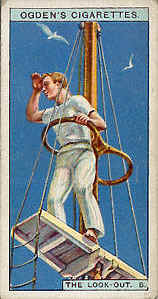 3
The Look Out - B. Southern type 3
The Look Out - B. Southern typeWhaling is by no means confined to the frozen seas of the Arctic and Antarctic, for the tropical and Southern seas are also hunted for whales. The "crow's nest" of a southern whaler consists merely of a slight platform resting on two cross trees at the head of the mainmast, and for the security of the observer two padded rings are fixed waist high. It is from this aerie that the magic cry comes floating down "Blo-o-o-w she blows!". At once all is excitement. |
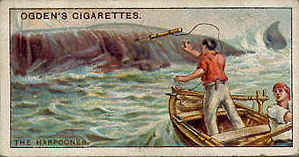 4
The Harpooner 4
The HarpoonerThe old time "Harpooner" was a skilled man and his place in the boat was at the oar nearest the bow. As the boat approached the whale, the harpooner secured the oar, picked up the harpoon, and placed his leg in the socket of the cleat (called the knee brace) and made ready. At the command "Give it to him" he hurled the harpoon with all his might into the body of the whale. The second harpoon was also discharged, and if it failed to reach the whale, it had to be cast over-board to avoid entanglement. When the whale was made fast by the harpoons, the killing was accomplished by a lance. |
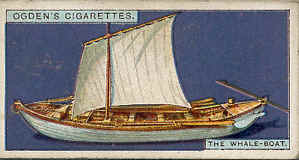 5
The Whale Boat 5
The Whale BoatThe old time whaling boat which was some 27-35 feet long, was rowed by oars or fitted with a simple sprit sail. Care had to be taken to keep every article in its place, for the slightest mistake would have endangered the lives of all in the boat. A deep slot in the bow received the line and a logger head was fixed around which the line was turned. In the forward thwart was the knee brace or clumsy cleat to steady the left thigh of the harpooner. The rowlocks were greased and padded to render the rowing as silent as possible. |
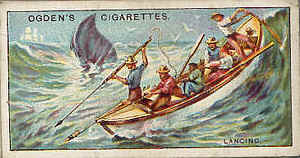 6
Lancing 6
LancingThe lance used by whaling vessels of the old type was a slender spear of malleable iron about four feet long attached to a handle of equal length. This was the weapon used for killing the whale, the harpoon being the only means of attaching the boat to the creature. When the harpooner had made fast, he went aft, and took the steering oar, changing places with the mate who took his place in the bow, lance in hand, ready to strike and finish the business. |
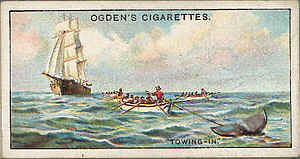 7 "Towing
- In" 7 "Towing
- In"The death of the whale is signaled by the spouting of blood, and the next procedure is to tow the carcase to the ship. Sometimes a hole is cut through the gristle of the tail, through which a line is rove, sometimes a line is passed round the small where the flukes of the tail join the body. The carcase is then towed alongside the ship, with the tail fastened near the bow, and the head under the gang-way, in the position for the process known as cutting in. |
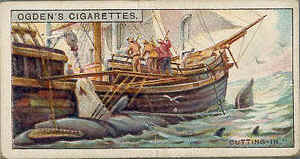 8 "Cutting
- In" 8 "Cutting
- In"The flensing or Cutting-in is accomplished from a platform projecting from the ships side, enabling the men engaged in stripping the whale of its blubber to work several feet above the carcase. The lower jaw, head, and blubber are cut away by means of a whaling-spade, a knife a foot or so in length, attached to a flexible sapling handle perhaps eighteen feet long. In heaving seas the process is one of great difficulty. |
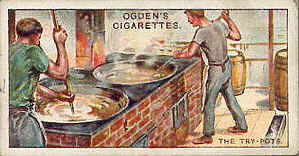 9
The Try-Pots 9
The Try-PotsIn the old-type whaling vessels the minced blubber was placed in large pans called the Try-pots, and the oil extracted by heat. The pots were set in brick work abaft the foremast, a deep tank of water being arranged beneath. The smoke stacks were built either of sheet iron or of copper and were usually rectangular. The extraction of the oil continued unceasingly until it was completed, the whole crew being divided into watches. In a modern whaler the sliced blubber is conveyed by an elevator to the steam boilers, from which the clear oil is finally pumped into enormous storage tanks in the lower hold. |
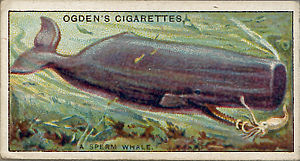 10
A Sperm Whale 10
A Sperm WhaleThe whale of the southern seas is the Sperm Whale. It has no "whale bone" in its mouth, but has a long jaw fitted with conical hard teeth It feeds in the ocean depths principally upon squid or great cuttle-fish some of which are of enormous size. Mr. F. T. Bullen speaks of a fragment disgorged by a whale, the tentacle of which was as thick as a mans body, and the sucking discs, as large as saucers. The Sperm Whale sees well in front but not behind, and this fact is remembered by the whaler in his method of attack. |
Cool Antarctica
Store - Pictures, Shirts, Calendars, Cards etc.

Lonely Planet travel guide Antarctica
![]() USA |
USA |
![]() UK
UK
![]() Free world delivery
Free world delivery
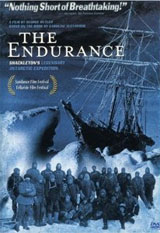
The Endurance -
Shackleton's Legendary Expedition
Dramatization with original footage
![]() DVD |
DVD |
![]() DVD
DVD

Custom Search
|
Home |
Site Map |
Pictures
|
Antarctica Stock Photos |
Facts |
History
| Antarctica Travel
| Antarctic Clothing
| Video
| Books
| Calendars |